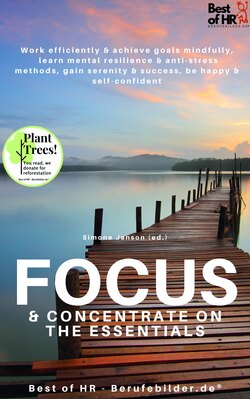Читать книгу Focus & Concentrate on the Essentials - Simone Janson - Страница 8
На сайте Литреса книга снята с продажи.
ОглавлениеEfficient and productive working in the open-plan office: 10 tips
// By Stephan Derr
All 3 minutes will be interrupted or diverted by a Büromitarbeiter on average. And it takes 23 minutes to get back to the original task. Reason enough to learn how concentration and efficiency can be increased.
Single Office - world leader
Today's working world often gives the impression that open spaces and large-scale offices have become normality. However, a recent study shows that the traditional single office still prevails.
Employees in some companies are now allowed to work from home or in the café, others have introduced flexible workplaces in their open-plan offices. Reports like these often give the appearance of a completely modern, mobile working world - but a recent study shows that reality lags behind this picture.
Single office outweighs open space
Despite increasing teamwork, there is more office space worldwide with individual offices than office space configured as open space. In Germany, this difference is particularly great:
For example, more than half of the employees still work in individual offices, only 19 percent in open-plan offices. Exactly the reverse is true in the UK, where only 14 percent work in individual offices, but already half of workers work in open spaces.
Tradition, status, power
A study conducted by Steelcase in collaboration with Ipsos further shows that individual offices continue to express hierarchies: the higher the rank of the employee in the company, the more likely he is to have his own office.
Because individual offices traditionally stand for status and independence, it's obvious why employees with their own office are often happier with their work environment.
Open Spaces: pros and cons
Today, however, our working life is more mobile and more team-oriented than ever before - individual offices are no longer modern in many cases. However, even though this awareness is slowly gaining ground, many employees still shy away from the counterpart, Großraumbüro.
These are so far automatically linked to noise and lack of privacy. Properly implemented, an open space, however, promotes cooperation and not the volume, it supports the communication between colleagues instead of individual ones, and contributes to more flexibility and commitment in the workplace.
Freedom of choice promotes commitment
An open space should be an open-minded, diverse system with different working environments, which offers the employees different possibilities depending on the task. This is because employees who are free to choose their workspace according to their current task are more satisfied and committed.
For the design of office space, this means bringing freedom of choice into our working worlds and questioning the traditional single office. This does not mean that all the individual offices are abolished. Flexibility is required in the future, which will do justice to everyone. The one, flat-rate solution does not exist - and that's good.
10 tips for more efficient work
But independent of a single office or open space How can one's own behavior actively control the attention and enable more efficient, productive work? We have collected 10 tips for you.
Some of these tips are known to surprise others. Therefore: Just try and work more efficiently!
1 Look out the window: The best ideas often come when the thoughts digress - before going to sleep or taking a shower. The brain then processes information in the background and creates new activation patterns. Here, it can help to think about something else, and then devote itself again to new ideas of problem solving.
2 To have the goal in mind: The brain must know how a task is designed precisely, in particular what content, which end and end it has. Tasks therefore need a clear beginning and an even clear end, so that the intellectual resources can be divided as best as possible.
3 To create a to-do list: The inner reward system longs for small successes. In doing so, checking off tasks by means of a list can help and significantly reduce the stress.
4 Talk to yourself: Instead of concentrating, thoughts often wander into the distance. Small secondary activities such as self-talk or doodle help to hide distractions and arrange the thoughts.
5 To take breaks: The brain can only record and process information on a limited basis. It is almost impossible to focus on a task longer than 45 minutes. Therefore the work should be divided and interrupted by several small breaks.
6 Search nearby: Attention is highly dependent on the proximity of neuronal stimuli. Spectators in the front row are more attentive than spectators in the last bench. So important is the physical proximity to the task or the conversation partner.
7 Take a deep breath: Regular meditation can contribute to a better focus and concentration. To work more efficiently and gain inner peace, but already regular, deep breathing.
8 To keep moving: Too long sitting will affect the concentration. Regular exercise, on the other hand, helps to promote learning, memory, and conceptual thinking.
9 Avoid multitasking: “Real” multitasking is a myth. In fact, attention fluctuates very quickly between different activities, which leads to errors. Therefore, it is better to prioritize tasks and do them one by one.
10 Sufficient sleep: Lack of sleep leads to mood fluctuations, but also to poor learning ability. To go to bed at the right time is worthwhile, because sufficient sleep provides for higher concentration and attention.
